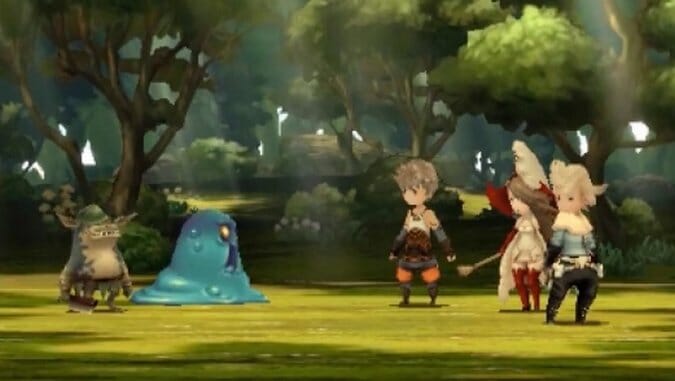Bravely Default

When a video game is announced I begin my review process by making a lot of jokes about the title on Twitter, such as “more like Bravely Default…on your loans,” and then nobody favs it and I look solemnly out of my window. But I was very happy to learn that, unquestionably on accident, Bravely Default makes loans the central feature of its battle system.
Bravely Default is a turn-based RPG, but it’s a game where you can also take multiple turns at once by stocking turns using “Default” and defending against enemy attack. This is the defend command of every other RPG, except it is actually useful this time. The best part about taking multiple turns is that you do not actually have to have those turns stocked. Bravely Default will totally let you take a loan out on future turns, and you will be able to act up to four times in one turn, at the cost of not acting for the next four turns. The puzzle of Bravely Default is deciding when to defend and when to act, while having the freedom to do a lot of things at once with a very heavy cost for doing so. The four heroes can also switch between two dozen classes and mix and match traits from each. Sometimes the random encounters seem too much (which you can turn down or off), and sometimes you need to fight a tedious number of monsters to get strong enough to beat a boss, but for the most part the game has fun combat-y parts.
Bravely Default also has a massive amount of online social features that are totally useless if you don’t live in a major metropolitan area. So, unless all the weed and electric guitars in Olympia turn into 3DSes tomorrow morning, I guess I can’t tell you much about the social features, other than that if you live in place like where I do, you might not be enjoying them. Their presence indicates that Bravely Default is a game that expects you to spend a lot of time with it. But you might find, like me, that Bravely Default has gotten a little ahead of itself in assuming how much of your time it has earned.
Square Enix often applies the Final Fantasy IP liberally to new games, and Bravely Default is so Final Fantasy that it might be more refreshing for classic fans—especially of, say, Final Fantasy V—or just people who like long fetch quests about giant crystals. Developed by the same team as Final Fantasy: The Four Heroes of Light for the DS and illustrated as well by Akihiko Yoshida, Bravely Default’s ever-cute characters and sweeping fantasy backdrops deliberately evoke the same sense of nostalgia. For Final Fantasy, this nostalgia is kind of fictional, not so much for the strangeness and quirks of the old RPGs but for what they almost-but-not-quite were, made up of Amano Yoshitaka concept art and lazy sundays and pixels blurry in the eyes of a child up at 2 in the morning. I think that is the idea. Lots of people will call this game a “classic” Final Fantasy, even though it contains no bizarrely translated dialogue or eye-hurting colors, nor is it at any point weird enough to be interesting.
Bravely Default starts out with a whole lot of cutscenes, seemingly as an FYI that this game is going to be a Final Fantasy game, but what it also starts out with is an AR movie for which you put your DS on your coffee table. Suddenly, an anime girl appears in your apartment, begging you for help against some kind of evil as rainbow cracks appear in your wall tapestries and Sailor Moon pillow, which she falls through, crying for your help.
